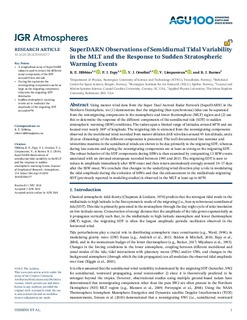| dc.contributor.author | Hibbins, Robert | |
| dc.contributor.author | Espy, Patrick Joseph | |
| dc.contributor.author | Orsolini, Yvan | |
| dc.contributor.author | Limpasuvan, Varavut | |
| dc.contributor.author | Barnes, R. J. | |
| dc.date.accessioned | 2019-05-29T08:35:51Z | |
| dc.date.available | 2019-05-29T08:35:51Z | |
| dc.date.created | 2019-05-24T14:10:02Z | |
| dc.date.issued | 2019 | |
| dc.identifier.citation | Journal of Geophysical Research - Atmospheres. 2019, 124, 4862-4872. | nb_NO |
| dc.identifier.issn | 2169-897X | |
| dc.identifier.uri | http://hdl.handle.net/11250/2599375 | |
| dc.description.abstract | Using meteor wind data from the Super Dual Auroral Radar Network (SuperDARN) in the Northern Hemisphere, we (1) demonstrate that the migrating (Sun‐synchronous) tides can be separated from the nonmigrating components in the mesosphere and lower thermosphere (MLT) region and (2) use this to determine the response of the different components of the semidiurnal tide (SDT) to sudden stratospheric warming (SSW) conditions. The radars span a limited range of latitudes around 60°N and are located over nearly 180° of longitude. The migrating tide is extracted from the nonmigrating components observed in the meridional wind recorded from meteor ablation drift velocities around 95‐km altitude, and a 20‐year climatology of the different components is presented. The well‐documented late summer and wintertime maxima in the semidiurnal winds are shown to be due primarily to the migrating SDT, whereas during late autumn and spring the nonmigrating components are at least as strong as the migrating SDT. The robust behavior of the SDT components during SSWs is then examined by compositing 13 SSW events associated with an elevated stratopause recorded between 1995 and 2013. The migrating SDT is seen to reduce in amplitude immediately after SSW onset and then return anomalously strongly around 10–17 days after the SSW onset. We conclude that changes in the underlying wind direction play a role in modulating the tidal amplitude during the evolution of SSWs and that the enhancement in the midlatitude migrating SDT (previously reported in modeling studies) is observed in the MLT at least up to 60°N. | nb_NO |
| dc.language.iso | eng | nb_NO |
| dc.rights | Attribution-NonCommercial-NoDerivatives 4.0 Internasjonal | * |
| dc.rights.uri | http://creativecommons.org/licenses/by-nc-nd/4.0/deed.no | * |
| dc.title | SuperDARN Observations of Semidiurnal Tidal Variability in the MLT and the Response to Sudden Stratospheric Warming Events | nb_NO |
| dc.type | Journal article | nb_NO |
| dc.type | Peer reviewed | nb_NO |
| dc.description.version | publishedVersion | nb_NO |
| dc.rights.holder | ©2019. The Authors. | nb_NO |
| dc.source.pagenumber | 4862-4872 | nb_NO |
| dc.source.volume | 124 | nb_NO |
| dc.source.journal | Journal of Geophysical Research - Atmospheres | nb_NO |
| dc.identifier.doi | 10.1029/2018JD030157 | |
| dc.identifier.cristin | 1700134 | |
| dc.relation.project | Norges forskningsråd: 223252 | nb_NO |
| cristin.unitcode | 7460,57,0,0 | |
| cristin.unitname | Atmosfære og klima | |
| cristin.ispublished | false | |
| cristin.fulltext | original | |
| cristin.qualitycode | 2 | |

